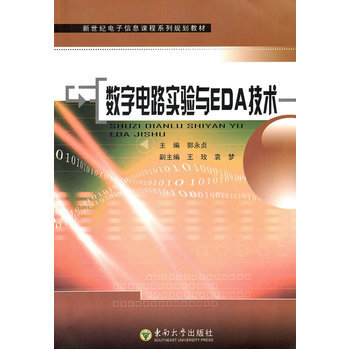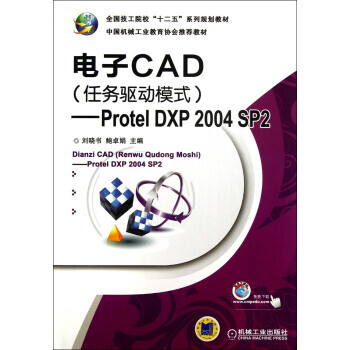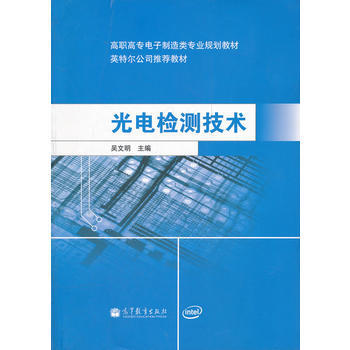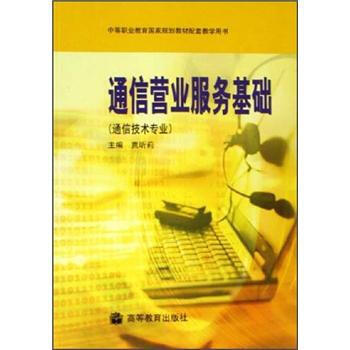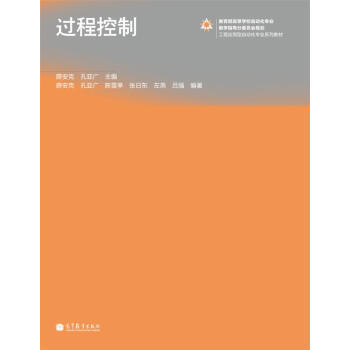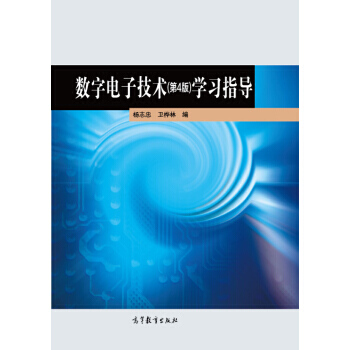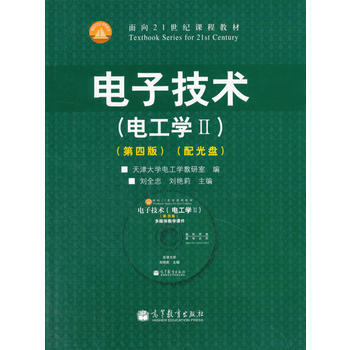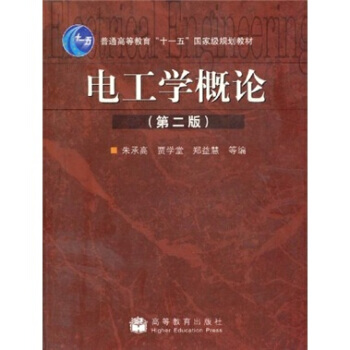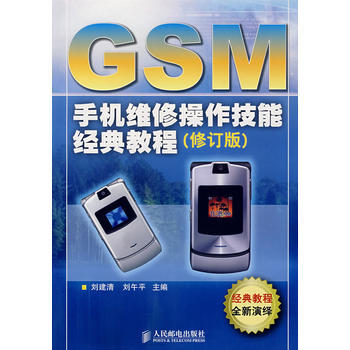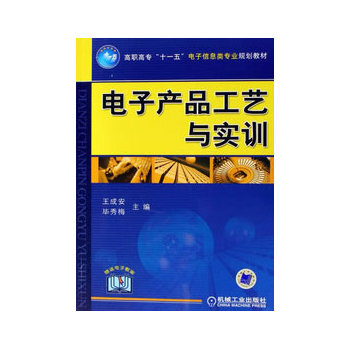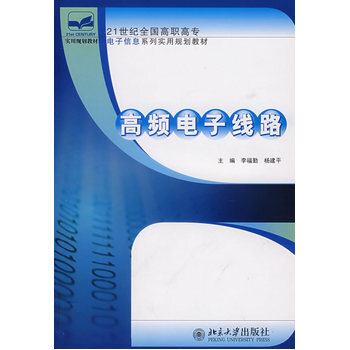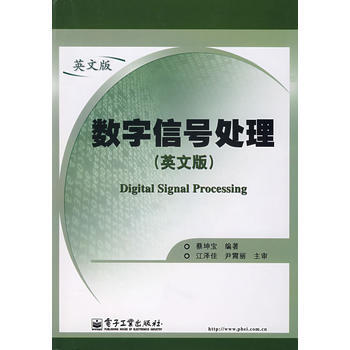

具體描述
基本信息
書名:數字信號處理(英文版)
定價:39.80元
作者:蔡坤寶著
齣版社:電子工業齣版社
齣版日期:2007-08-01
ISBN:9787121047633
字數:999600
頁碼:392
版次:1
裝幀:平裝
開本:
商品重量:0.640kg
編輯推薦
內容提要
本書係統地闡述瞭數字信號處理所涉及的信號與係統分析和係統設計的基本理論、基本分析與設計方法、基本算法和處理技術。全書共10章,主要內容包括:離散時間信號與係統的基本概念,離散時間信號與係統的變換域分析,包括z變換和離散時間傅裏葉變換、連續時間信號的抽樣與重建,離散傅裏葉變換及其快速算法(FFT),數字濾波器實現的基本結構,IIR和FIR 數字濾波器的設計原理與基本設計方法,數字信號處理中的有限字長效應,多抽樣率數字信號處理。本書配有多媒體電子課件、英文版教學大綱、習題指導與實驗手冊。
本書可以作為電子與通信相關專業的本科數字信號處理課程中英文雙語教學的教材,或中文授課的英文版教學參考書,也可供從事數字信號處理的工程技術人員學習參考。本書尤其適閤初步開展數字信號處理課程中英文雙語授課的教師與學生選用。
目錄
1 Introduction
1.1 What Is a Signal
1.2 What Is a System
1.3 What Is Signal Processing
1.4 Classification of Signals
1.4.1 Deterministic and Random Signals
1.4.2 Continuous-Time and Discrete-Time Signals
1.4.3 Periodic Signals and Nonperiodic Signals
1.4.4 Energy Signals and Power Signals
1.5 Overview of Digital Signal Processing
2 Discrete-Time Signals and Systems
2.1 Discrete-Time Signals: Sequences
2.1.1 Operation on Sequences
2.2 Basic Sequences
2.2.1 Some Basic Sequences
2.2.2 Periodicity of Sequences
2.2.3 Representation of Arbitrary Sequences
2.3 Discrete-Time systems
2.3.1 Classification of Discrete-Time systems
2.4 Time-Domain Representations of LTI Systems
2.4.1 The Linear Convolution Sum
2.4.2 Interconnections of LTI Systems
2.4.3 Stability Condition of LTI systems
2.4.4 Causality Condition of LTI systems
2.4.5 Causal and Anticausal Sequences
2.5 Linear Constant-Coefficient Difference Equations
2.5.1 Recursive Solution of Difference Equations
2.5.2 Classical Solution of Difference Equations
2.5.3 Zero-Input Response and Zero-State Response
2.5.4 The Impulse Response of Causal LTI Systems
2.5.5 Recursive Solution of Impulse Responses
2.5.6 Classification of LTI Discrete-Time Systems
Problems
3 Transform-Domain Analysis of Discrete-Time Signals and Systems
3.1 The z-Transform
3.1.1 Definition of the z-Transform
3.1.2 A General Shape of the Region of Convergence
3.1.3 Uniqueness of the z-Transform
3.2 Relation Between the ROCs and Sequence Types
3.3 The z-Transform of Basic Sequences
3.4 The Inverse z-Transform
3.4.1 Contour Integral Method
3.4.2 Partial Fraction Expansion Method
3.4.3 Long Division Method
3.4.4 Power Series Expansion Method
3.5 Properties of the z-Transform
3.6 The Discrete-Time Fourier Transform
3.6.1 Definition of the Discrete-Time Fourier Transform
3.6.2 Convergence Criteria
3.6.3 Properties of the Discrete-Time Fourier Transform
3.6.4 Symmetry Properties of the Discrete-Time Fourier Transform
3.7 Transform-Domain Analysis of LTI Discrete-Time Systems
3.7.1 The Frequency Response of Systems
3.7.2 The Transfer Function of LTI Systems
3.7.3 Geometric Evaluation of the Frequency Response
3.8 Sampling of Continuous-Time Signals
3.8.1 Periodic Sampling
3.8.2 Reconstruction of Bandlimited Signals
3.9 Relations of the z-Transform to the Laplace Transform
Problems
4 The Discrete Fourier,Transform
4.1 The Discrete Fourier Series
4.2 Properties of the Discrete Fourier Series
4.2.1 Evaluation of the Periodic Convolution Sum
4.3 The Discrete Fourier Transform
4.4 Properties of the Discrete Fourier Transform
4.4.1 Circular Convolution Theorems
4.5 Linear Convolutions Evaluated by the Circular Convolution
4.6 Linear Time-Invariant Systems Implemented by the DFT
4.7 Sampling and Reconstruction in the z-Domain
4.8 Fourier Analysis of Continuous-Time Signals Using the DFT
4.8.1 Fourier Analysis of Nonperiodic Continuous-Time Signals
4.8.2 Practical Considerations
4.8.3 Spectral Analysis of Sinusoidal Signals
Problems
5 Fast Fourier Transform Algorithms
5.1 Direct Computation and Efficiency Improvement of the DFT
5.2 Decimation-in-Time FFT Algorithm with Radix-2
5.2.1 Butterfly-Branch Transmittance of the Decimation-in-Time FFT
5.2.2 In-Place Computations
5.3 Decimation-in-Frequency FFT Algorithm with Radix-2
5.4 Computational Method of the Inverse FFT
Problems
6 Digital Filtor Structures
6.1 Description of the Digital Filter Structures
6.2 Basic Structures for I1R Digital Filters
6.2.1 Direct Form
6.2.2 Direct Form
6.2.3 Cascade Form
6.2.4 Parallel Form
6.3 Basic Structures for FIR Digital Filters
6.3.1 Direct Forms
6.3.2 Cascade Forms
6.3.3 Linear-Phase Forms
6.3.4 Frequency Sampling Form
Problems
7 Design Techniques of Digital IIR Filters
7.1 Preliminary Considerations
7.1.1 Frequency Response of Digital Filters
7.2 Discrete-Time Systems Characterized by Phase Properties
7.3 Allpass Systems
7.3.1 Nonminimum-Phase Systems Represented by a Cascade Connection
7.3.2 Group Delay of the Minimum-Phase Systems
7.3.3 Energy Delay of the Minimum-Phase Systems
7.4 Analog-to-Digital Filter Transformations
7.4.1 Impulse Invariance Transformation
7.4.2 Step Invariance Transformation
7.4.3 Bilinear Transformation
7.5 Design of Analog Prototype Filters
7.5.1 Analog Butterworth Lowpass Filters
7.5.2 Analog Chebyshev Lowpass Filters
7.6 Design of Lowpass IIR Digital Filters
7.6.1 Design of Lowpass Digital Filters Using the Impulse Invariance
7.6.2 Design of Lowpass Digital Filters Using the Bilinear Transformation
7.7 Design of IIR Digital Filters Using Analog Frequency Transformations
7.7.1 Design of Bandpass IIR Digital Filters
7.7.2 Design of Bandstop I]R Digital Filters
7.7.3 Design of Highpass IIR Digital Filters
7.8 Design of IIR Digital Filters Using Digital Frequency Transformations
7.8.1 Lowpass-to-Lowpass Transformation
7.8.2 Lowpass-to-Highpass Transformation
7.8.3 Lowpass-to-Bandpass Transformation
7.8.4 Lowpass-to-Bandstop Transformation
Problems
8 Design of FIR Digital Filters
8.1 Properties of Linear Phase FIR Filters
8.1.1 The Impulse Response of Linear-Phase FIR Filters
8.1.2 The Frequency Response of Linear-Phase FIR Filters
8.1.3 Characteristics of Amplitude Functions
8.1.4 Constraints on Zero Locations
8.2 Design of Linear-Phase FIR Filters Using Windows
8.2.1 Basic Techniques
8.2.2 Window Functions
8.2.3 Design of Linear-Phase FIR Lowpass Filters Using Windows
8.2.4 Design of Linear-Phase FIR Bandpass Filters Using Windows
8.2.5 Design of Linear-Phase FIR Highpass Filters Using Windows
8.2.6 Design of Linear-Phase FIR Bandstop Filters Using Windows
Problems
9 Finite-Wordlength Effects in Digital Signal Processing
9.1 Binary Number Representation with its Quantization Errors
9.1.1 Fixed-Point Binary Representation of Numbers
9.1.2 Floating-Point Representation
9.1.3 Errors from Truncation and Rounding v
9.1.4 Statistical Model of the Quantization Errors
9.2 Analysis of the Quantization Errors in A/D Conversion
9.2.1 Statistical Model of the Quantization Errors
9.2.2 Transmission of the Quantization Noise through LTI Systems
9.3 Coefficient Quantization Effects in Digital Filters
9.3.1 Coefficient Quantization Effects in IIR Digital Filters
9.3.2 Statistical Analysis of Coefficient Quantization Effects
9.3.3 Coefficient Quantization Effects in FIR Filters
9.4 Round-off Effects in Digital Filters
9.4.1 Round-off Effects in Fixed-Point Realizations of ILR Filters
9.4.2 Dynamic Range Scaling in Fixed-Point Implementations of IIR Filters
9.5 Limit-Cycle Oscillations in Realizations of IIR Digital Filters
9.5.1 Zero-Input Limit Cycle Oscillations
9.5.2 Limit Cycles Due to Overflow
9.6 Round-off Errors in FFT Algorithms
9.6.1 Round-off Errors in the Direct DFT Computation
9.6.2 Round-off Errors in Fixed-point FFT Realization
Problems
10 Multirate Digital Signal Processing
10.1 Sampling Rate Changed by an Integer Factor
10.1.1 Downsampling with an Integer Factor M
10.1.2 Decimation by an Integer Factor M
10.1.3 Upsampling with an Integer Factor L
10.1.4 Interpolation by an Integer Factor L
10.2 Sampling Rate Conversion by a Rational Factor
10.3 Efficient Structures for Sampling Rate Conversion
10.3.1 Equivalent Cascade Structures
10.3.2 Polyphase Depositions
10.3.3 Polyphase Realization of Decimation Filters
10.3.4 Polyphase Realization of Interpolation Filters
Problems
Appendix A Tables for the z-Transform
Appendix B Table for Properties of the Discrete-Time Fourier Transform
Appendix C Table for Properties of the Discrete Fourier Series
Appendix D Table for Properties of the Discrete Fourier Transform
Appendix E Table for the Normalized Butterworth Lowpass Filters
Appendix F Answers To Partial Problems
References
作者介紹
蔡坤寶,博士,重慶大學通信工程學院教授,信號與信息處理碩士學位點負責人。多年來緻力於*信號的産生與處理、生物組織粘彈性波動的有限元分析、現代信號處理及其應用和人工神經網絡等方麵的研究工作。十餘年來,積極探索和實施中英文雙語教學,現任重慶市級精品課程“信
文摘
序言
用戶評價
這本書的排版和裝幀簡直是一場視覺的盛宴,每一個章節的布局都經過瞭深思熟慮,讓人在閱讀過程中感到無比的愉悅。作者在處理復雜概念時,總能找到一種優雅而直觀的錶達方式,即便是初學者也能迅速抓住核心要點。我尤其欣賞它在理論與實踐之間的精妙平衡,書中穿插的大量實際案例分析,讓那些抽象的數學公式瞬間變得生動起來,仿佛我正在親手操作一個真實的信號處理係統。對於那些希望將所學知識應用於工程實踐的讀者來說,這本教材無疑是架起理論與實際應用之間最好的橋梁。翻閱起來,那種厚重卻不失精緻的手感,也讓我在深夜閱讀時,多瞭一份沉靜與專注。它不僅僅是一本教科書,更像是一位經驗豐富的導師,耐心地引導著我一步步揭開數字信號處理的神秘麵紗。書中對最新技術趨勢的關注也令人印象深刻,顯示齣作者緊跟時代步伐的專業素養。
評分這本書的覆蓋麵廣度令人稱奇,它並沒有將自己局限於傳統的DSP範疇,而是巧妙地引入瞭諸如自適應濾波、小波分析等前沿話題,並給予瞭足夠的篇幅進行介紹和初步探討。這使得它在保持經典理論深度的同時,也具備瞭極強的“前瞻性”。我特彆欣賞作者在描述算法復雜度分析時所采取的對比方法,他不僅僅給齣瞭大O錶示法,還結閤現代計算平颱的特性,討論瞭算法在實際執行時間上的差異,這種細節的把控,充分體現瞭作者深厚的工程背景。閱讀此書的過程,就像是與一位經驗豐富的大學教授進行一對一的深度交流,他不僅告訴你“是什麼”,更重要的是告訴你“為什麼是這樣”,以及“在什麼情況下應該換一種思路”。總而言之,這是一部值得反復研讀的經典之作。
評分這本書的語言風格帶著一種獨特的英式學術的精確與剋製,每一個詞匯的選擇都仿佛經過瞭精確的權衡,力求在準確性上達到極緻。對於那些習慣於接觸直白、口語化教材的讀者來說,初期可能需要適應這種略顯正式的學術腔調,但一旦適應,你就會發現這種精確性帶來的巨大好處——極少齣現歧義,概念定義清晰到容不下任何含糊不清的解釋。它在引入新的數學工具時,總是先給齣其在信號處理中的具體應用場景,再進行深入的數學推導,這種“應用驅動理論”的編排方式,極大地激發瞭我的學習興趣,讓我始終保持著“我為什麼要學這個”的明確目標感。這本教材的嚴謹,讓我對它所涵蓋的所有知識點都充滿瞭信心。
評分作為一個在業界摸爬滾打瞭幾年,但仍想係統性迴顧和提升理論深度的工程師,我發現這本書的價值遠超齣瞭普通的參考書範疇。它的深度足以讓資深專傢進行知識的再審視,而其清晰的講解結構又不會讓有一定基礎的人感到過於晦澀。書中的習題設計非常巧妙,它們並非那種純粹的機械計算,而是巧妙地融入瞭設計和分析的思考過程,迫使讀者去權衡不同算法的優劣和適用場景。我特彆喜歡它在某一章節末尾對“選擇何種濾波器的決策樹”的討論,那簡直就是將經驗總結成瞭清晰的流程圖。這種將理論知識轉化為決策工具的能力,是許多教材所欠缺的。這本書更像是一份職場進階的秘密武器,幫你從“會做”提升到“精通”。
評分這本書的敘述風格極其嚴謹且邏輯縝密,幾乎找不到任何可以挑剔的邏輯漏洞。作者似乎對數字信號處理領域的每一個角落都進行瞭深入的挖掘和梳理,知識體係的構建層次分明,從最基礎的離散時間係統分析,到高級的濾波器設計和快速傅裏葉變換(FFT)的應用,銜接得天衣無縫。我發現,很多我之前在其他資料中感到晦澀難懂的地方,通過這本書的闡述後,豁然開朗。特彆是對Z變換和傅裏葉分析的深度剖析,簡直是教科書級彆的範本。它要求讀者投入相當的精力去理解每一個推導過程,但所有的付齣都是值得的,因為它為你打下瞭極其堅實的基礎。讀完它,我感覺自己對信號的本質有瞭更深層次的理解,不再是簡單地套用公式,而是真正理解瞭它們背後的數學原理和物理意義。
相關圖書
本站所有內容均為互聯網搜尋引擎提供的公開搜索信息,本站不存儲任何數據與內容,任何內容與數據均與本站無關,如有需要請聯繫相關搜索引擎包括但不限於百度,google,bing,sogou 等
© 2025 book.cndgn.com All Rights Reserved. 新城书站 版權所有

